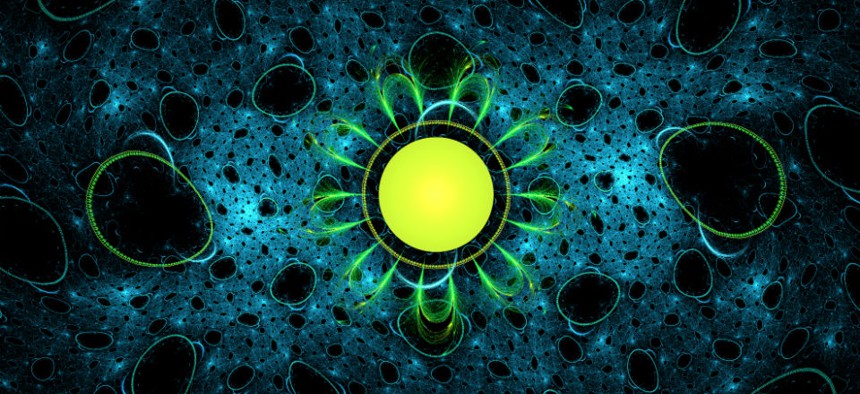Gecko Toe Hair and Other Magnified Scientific Images on Display at NIH

sakkmesterke/Shutterstock.com
The foreign familiarity of the cellular world on exhibit.
Our universe is a vast and repeating tapestry of convergences.
This how we experience it anyway, and in part because our brains are hardwired to recognize patterns. We can't help but see the fractal echo of tributaries in a blown-up image of our own capillaries. And it makes sense that a network of Earth's waterways might resemble a system of human blood vessels; it's just not the sort of observation that most vantage points allow.
Looking at something familiar from an unfamiliar perspective—often from very far away or from very close up—can be revealing this way. Such perspectives abound in science, where microscopes and telescopes allow us to access new worlds over extreme distances and through painstaking repetition.
You can catch a glimpse of this world in a new exhibit curated by the National Institutes of Health called Life: Magnified, which includes remarkable scientific images—many come from NIH-backed projects—including a striking forest of gecko toe hair, the sunflower burst of a human liver cell, the fine spiderwebbing that creeps up blood vessel walls, and stunning solar systems of cells. The American Society for Cell Biology's director calls it a "dazzling trip through the cellular world, which is both foreign and as close as [your] own skin."
This close-up of a gecko’s foot shows some of its 500,000 toe hairs, each one about one-tenth the thickness of a single human hair. (As in many images like these, color serves many purposes here—to reveal, to separate, to delight—and isn’t always the “true” color of the microscopy.)

Here's the cerebellum of a mouse in cross-section. (People with damage to this region of the brain often have trouble with fine motor skills.)

Here's one of the most abundant types of cells in the human liver. (It helps process molecules "found normally in the body, like hormones, as well as foreign substances like medicines and alcohol.")

Here's a super close-up look at a mouse eye, with each variation in color representing a different type of cell. All in all, there are 70 cell types, "including the retina’s many rings and the peach-colored muscle cells clustered on the left."

Here's another close-up view of the cerebellum, the brain’s "locomotion control center."

Here are the sound-sensing cells that extend into the fluid-filled tube of the inner ear. The NIH explains: "When sound reaches the ear, the hairs bend and the cells convert this movement into signals that are relayed to the brain. When we pump up the music in our cars or join tens of thousands of cheering fans at a football stadium, the noise can make the hairs bend so far that they actually break, resulting in long-term hearing loss."

Here's the webby sheath that covers the developing egg chambers in a giant lubber grasshopper . (You're probably seen these bugs if you live in the southeastern or south central United States.) Again, from the NIH: "Unlike mammals, which have red blood cells that carry oxygen throughout the body, insects have breathing tubes that carry air through their exoskeleton directly to where it’s needed. This image shows the breathing tubes embedded in the weblike sheath cells that cover developing egg chambers."

Here's a U.S. Army image of anthrax bacterium (pictured here in green) being swallowed by an immune system cell (the purple part).

Here are some
Purkinje cells
, one of the main types of nerve cell found in the brain.

This is the structure of the endothelium, "the thin layer of cells that line our arteries and veins." The NIH describes the endothelium as a "gatekeeper" that controls what moves in and out of the bloodstream. The red stuff is specialized proteins that act like strong ropes. The blue part is the cement that holds everything together.

Here's the ovary cross-section of an anglerfish. Eventually, these eggs will be released in a "gelatinous, floating mass" that can be up to three feet long and include hundreds of thousands of eggs.

The cells shown below are fibroblasts, one of the most common cells in your connective tissue—although the cells here came from a mouse. "The DNA within the nucleus (blue), mitochondria (green) and cellular skeleton (red) is clearly visible."

This image shows Q-fever bacteria, which can infect cows, sheep, goats, and humans.

Here are the mouth parts of the lone star tick. Those yellow barbs are what help keep the tick stuck to its host.

Here's the fin of a developing zebrafish, a favorite subject for scientists exploring how genes guide the early stages of prenatal development.

The entire collection is on display in the C concourse at Washington Dulles International Airport, but you can also check it out the rest of it online.
( Image via sakkmesterke / Shutterstock.com )





